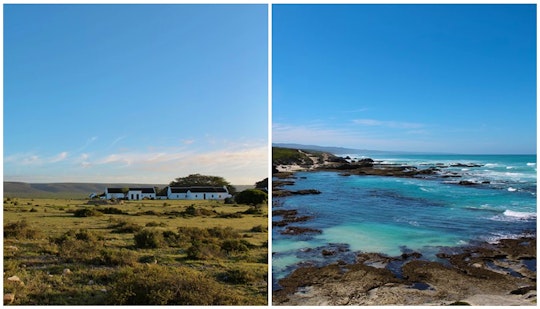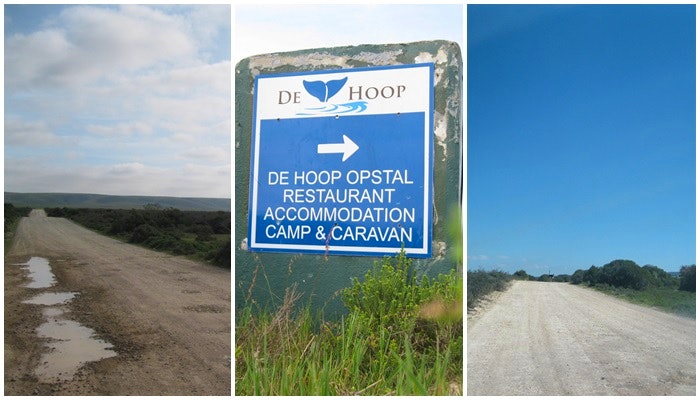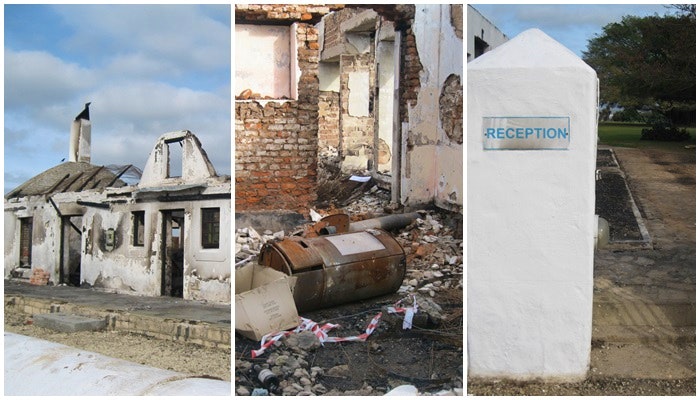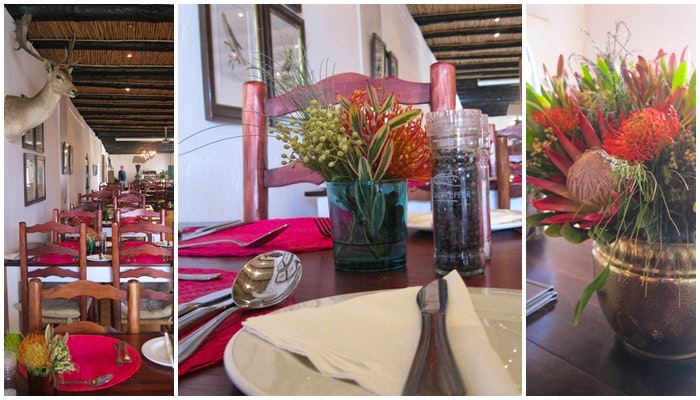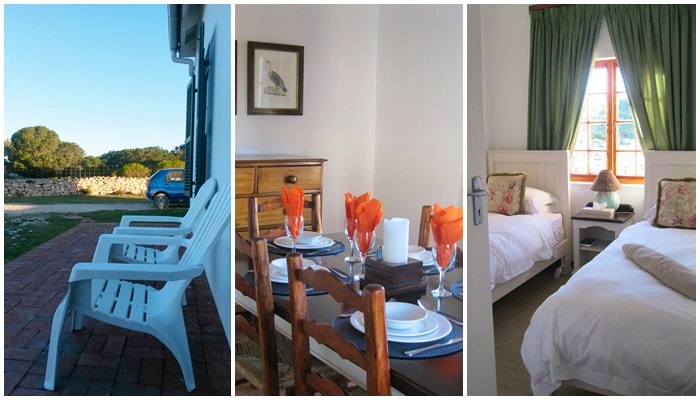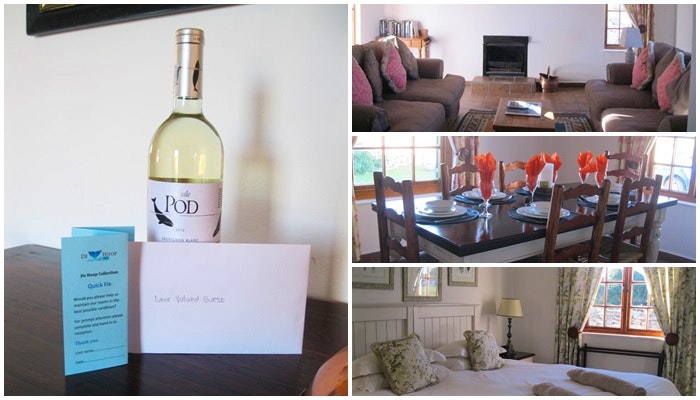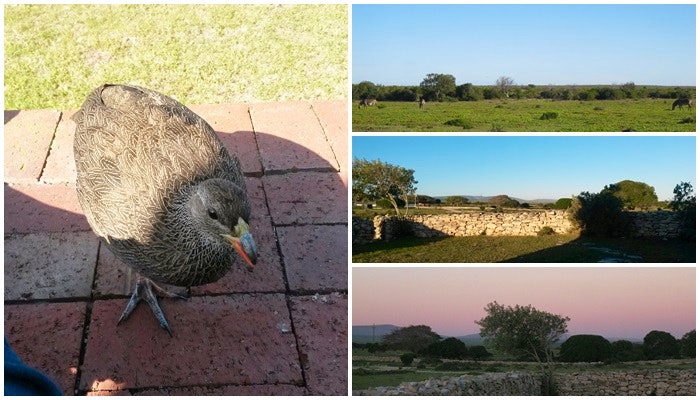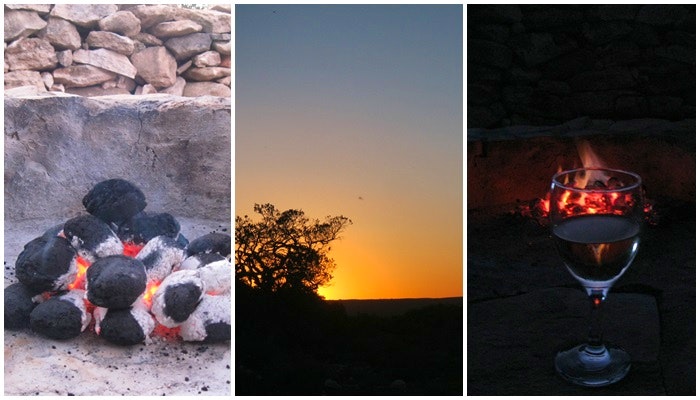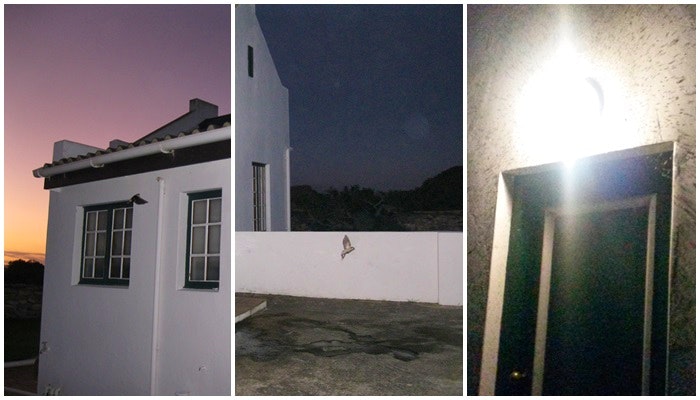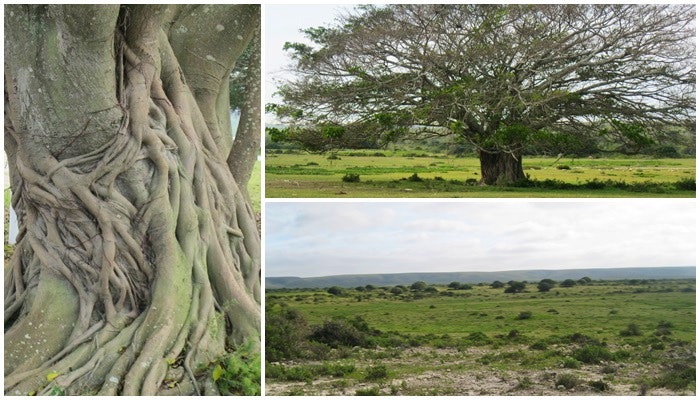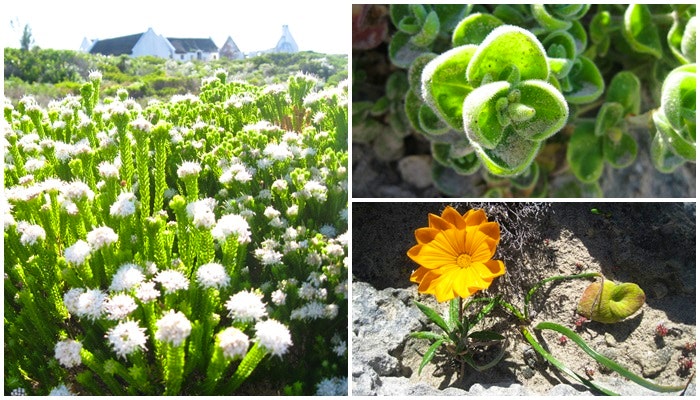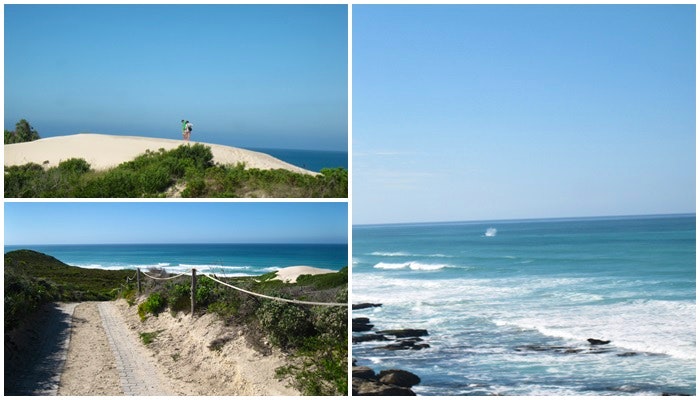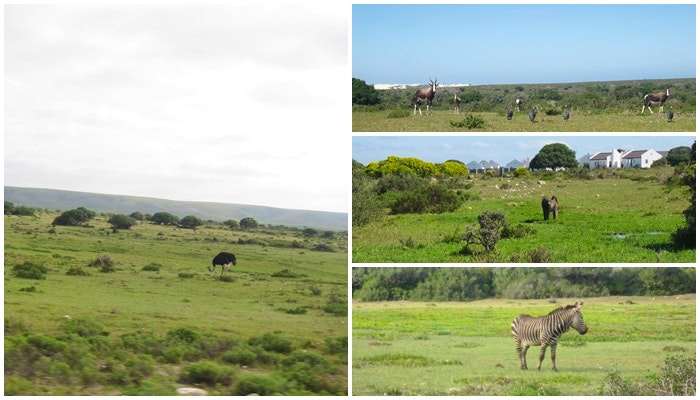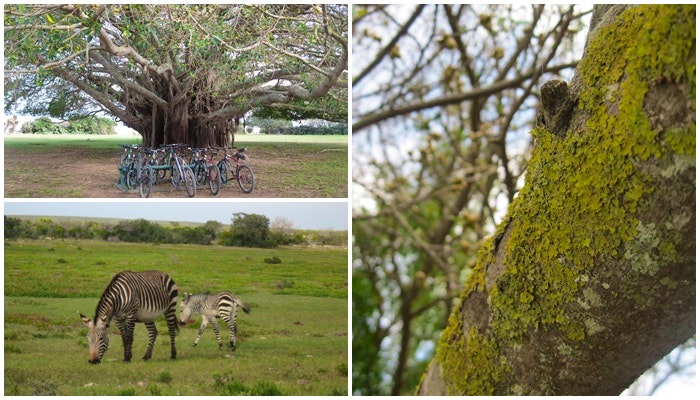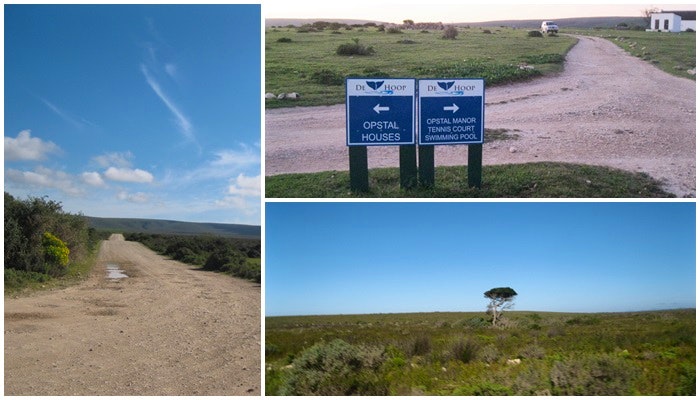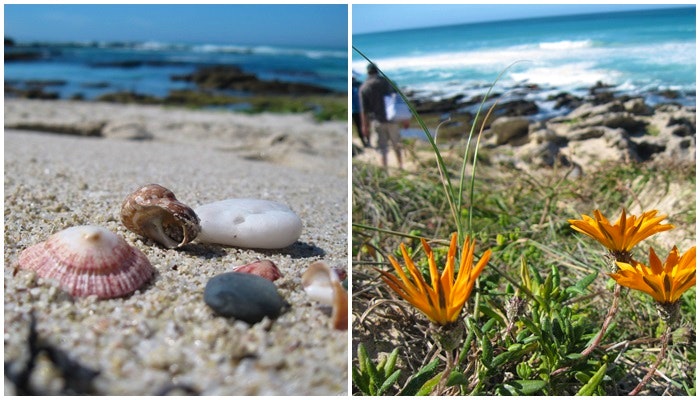After 33km of navigating a bumpy dirt road in our tiny Fiat Palio, I was left feeling a lot more like a martini being shaken – not stirred – than an excited first time visitor to one of the most beautiful parts of the Cape: De Hoop Nature Reserve.
We finally arrived at our destination and started driving down yet another dirt road. But somehow, this dirt road was different.
The ocean suddenly appeared behind snow-white sand dunes, and elands and kudu briefly showed face before disappearing back into the surrounding bush. We were alone in a magical landscape at the ends of the earth, with only the local bird and wildlife to keep us company. I even forgot about my aching tailbone.
De Hoop Reception & Restaurant
The reception lies behind the burnt-out husk of the old Fig Tree Restaurant, and doubles as a gift shop, with items available for purchase such as sunscreen, hats, sunglasses, sarongs, and even braai packs. At first glance, they are a bit pricey but if you factor in petrol, and driving 60km down a dirt road to reach the nearest town, they suddenly become very cost effective if you forgot to pack any of these items.
Across the field from the reception, which is dominated by two giant fig trees, you’ll find the new Fig Tree Restaurant running out of the Opstal. They are open daily for breakfast, lunch, and dinner, and you could easily spend an hour or more enjoying the unique décor, delicious food, assorted beverages, and shady outdoor tables – do try a Dom Pedro while here, they’re delicious! It’s highly recommended to book dinner in advance.
De Hoop Cottage Collection
The De Hoop Cottages are beautifully appointed and well-suited for weekend adventurers. When we entered the stone-ringed Blue Crane Opstal House – which has plenty of old world charm, along with modern conveniences – we felt at home.
From the little fireplace in the lounge and fully laid-out dining area, to the equipped kitchen and bedrooms, all you could possibly need was available. The views from the bedrooms were lovely – overlooking ancient stone walls and the timeless landscape beyond them. The beds were comfortable and decked in the old-fashioned linens – a signature style of De Hoop – which were soft, cosy, and more than adequate for our weekend stay. Our group appreciated the electric blankets on the beds, along with extra blankets and hot water bottles in the cupboards.
On the front stoep, there were two cosy wooden chairs looking out at the landscape beyond the historical stone wall. Keep your eye out for any friendly Francolins who may visit.
The back yard was also comfortable with a large garden, a shady tree, and a picnic bench next to the stone braai area, which we made good use of throughout the weekend.
Tips:
– Do not leave any windows open if the inside lights are on. You WILL have an eclipse of moths appear and try to snuff out the light with their wings – and possibly you too if you carry a torch.
– That said, do bring a torch or external light with you if you plan to braai – the braai is located away from the main cottage and has no lighting of its own.
– Remember that the plates, bowls, cutlery and glasses are on the dining table – not the cupboards.
– As baboon troops roam the property, it’s advisable not to leave any doors or windows open; if you receive a knock on the door after hours, check before you open the door – as the De Hoop baboons have recently started learning manners.
De Hoop Nature Reserve
The De Hoop Nature Reserve is a World Heritage Site that is fully deserving of any and all hype it receives. Spanning 34, 000 hectares of fynbos covered grounds, sweeping coastlines, and towering dunes, De Hoop has a diverse ecosphere. As there are over 300 wildlife, marine life and avian species to see, it’s recommended you grab a R10 De Hoop guidebook at reception to keep track of them.
Birdlife
October and November are the best birding months at De Hoop, with a variety of migratory species visiting, and local birds courting. You may even spot some Cape Sparrows at sunset. They came in diving and chirping above our campfire before returning to their nest in the eaves of our cottage. Daylight hours yielded sightings of hadada, kestrels, francolins, egretsheron, and many others.
Marine life
Although Hermanus and Langebaan are revered as whale-watching towns, you’ll spot more than just a pod of whales at De Hoop during whale season. Throughout spring, the chilly bay is filled with gargantuan black bodies spouting water in the distance, as they frolic in the water and teach their calves to roll and wave. Other marine life in the bay includes shysharks, rockcod, klipfish, and dikoog fansmadam.
Wildlife
Wildlife is abundant, with a variety of buck (eland, kudu, gemsbok, duiker), ostriches, and baboon troops wandering the plains, while smaller species include shrews, genet, mongoose, rabbits, badgers, and otters. De Hoop also has its fair share of nocturnal species like bats, snake species such as the Cape cobra, and slow-movers like tortoises.
ACTIVITIES
With a tennis court, swimming pool, jungle gym, boules, cycling trails, hiking trails, bird watching, marine walks, game drives, and star gazing available, you really can choose to do as much or as little as you want.
– Bicycles are available for rental at R50 for an hour or R150 for a full day. I’m a bit embarrassed to admit that I learnt how to ride a bicycle while at De Hoop, much to the amusement of reception staff and my husband. But conquer the bicycle I did – and the setting couldn’t have been more beautiful or memorable. There are 4 cycling trails available which wind through various routes in the reserve, ranging from 12km – 30km trail; which is recommended only for experienced riders.
– Star gazing is free if you do it in your chalet’s back yard, but if you’re a star gazing novice you’d be better off going on a 1 hour guided Star Gazing Tour. After paying a small fee, visitors meet outside of Fig Tree Restaurant to begin the star gazing, weather dependent.
– Eco Quad Biking offers the chance to experience the world’s smallest and most threatened plant kingdom – The Cape Floral Kingdom. Spot the 34 floral species which only occur at De Hoop, the 108 rare and threatened plant species, or the 14 newly discovered floral species. This tour is not for the adrenaline junkies who want to race across the dunes or plough into the bush.
– The Marine Walk Adventure at De Hoop is the most recommended experience!
– The Vlei is a dominating feature of the reserve and it is home to diverse birdlife.
– Game Viewing at De Hoop will not include South Africa’s Big 5, but you’ll definitely make some incredible memories.
– The Guided Bird & Fynbos Walk is ideal for nature enthusiasts, despite the very early start of 06h00 in spring and summer, and 08h00 in autumn and winter.
– Guided Mountain Bike Trails include cycling amid herds of eland and other buck species. Your guide will also point out lesser known features of the reserve, along with historical aspects that you may not spot on your own.
Head to De Hoop Nature Reserve to experience serenity at the edge of the earth, and discover the unique creatures that thrive here. Let us know when you’ll be visiting!
Main image kindly provided by Peter Hanley.

